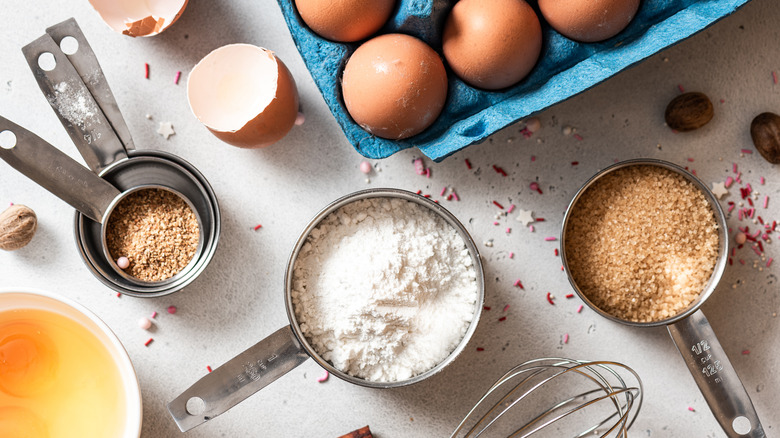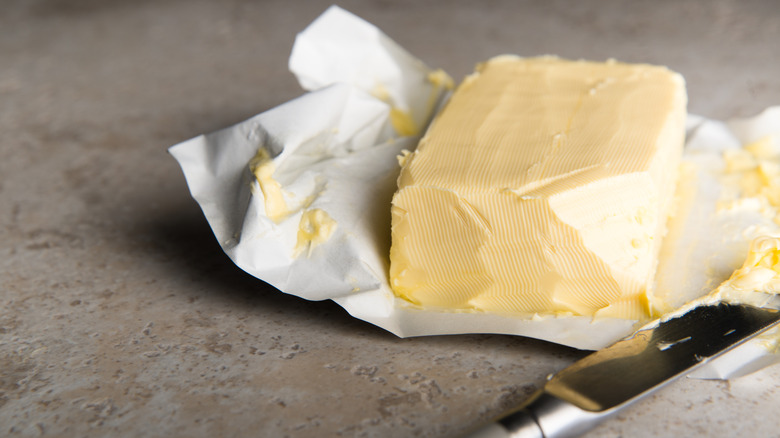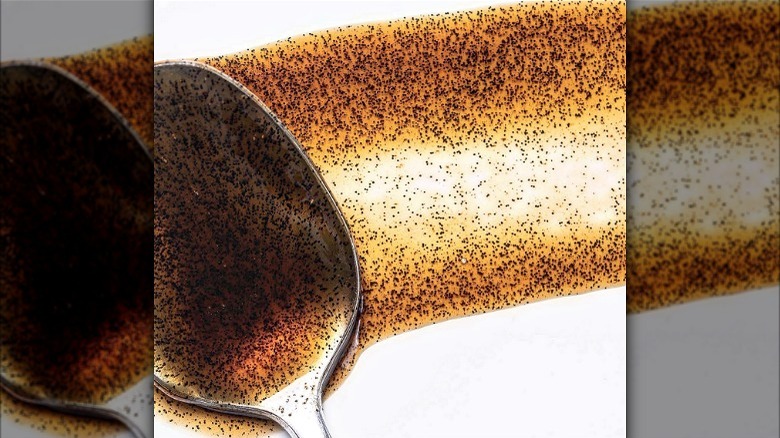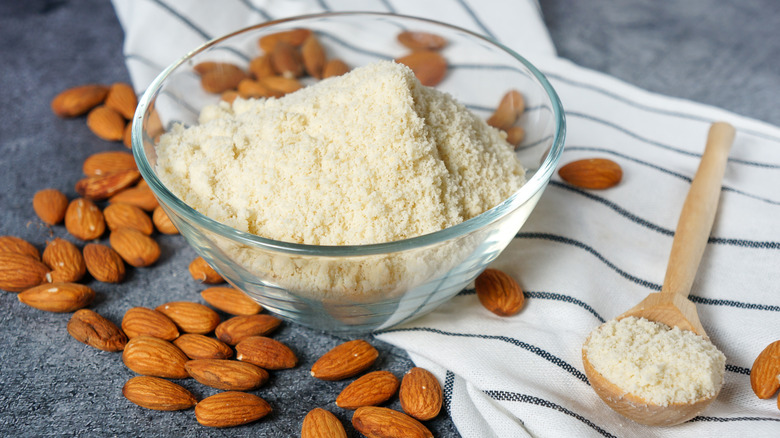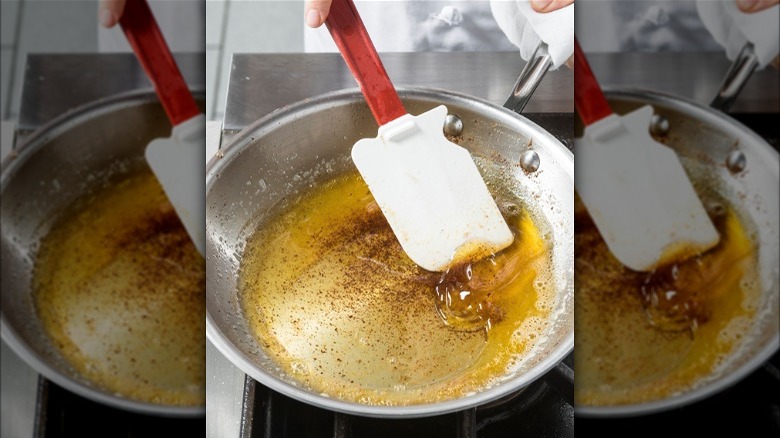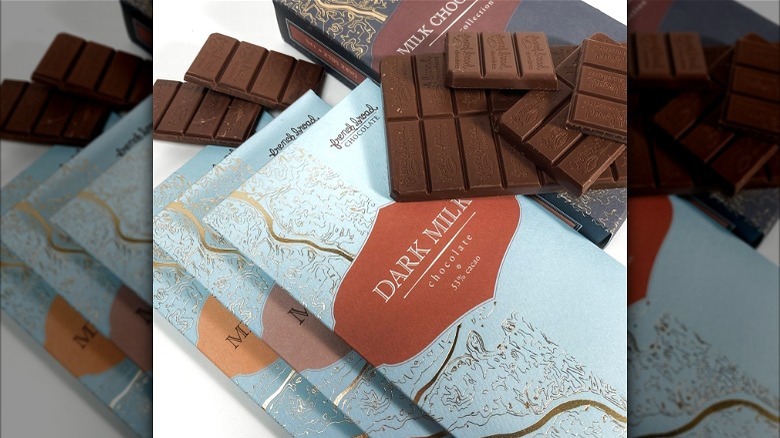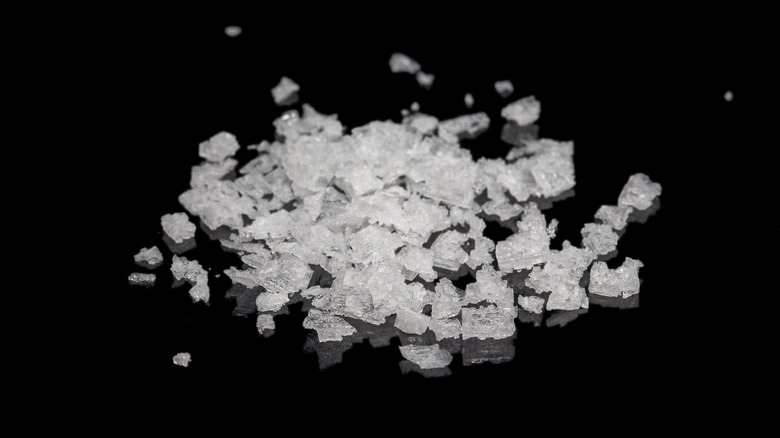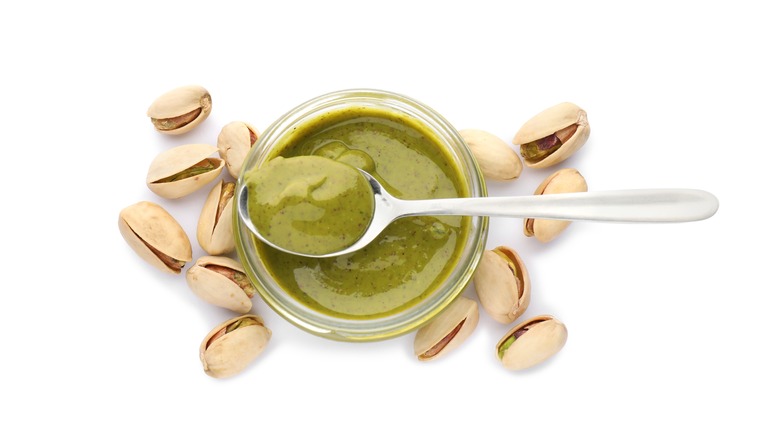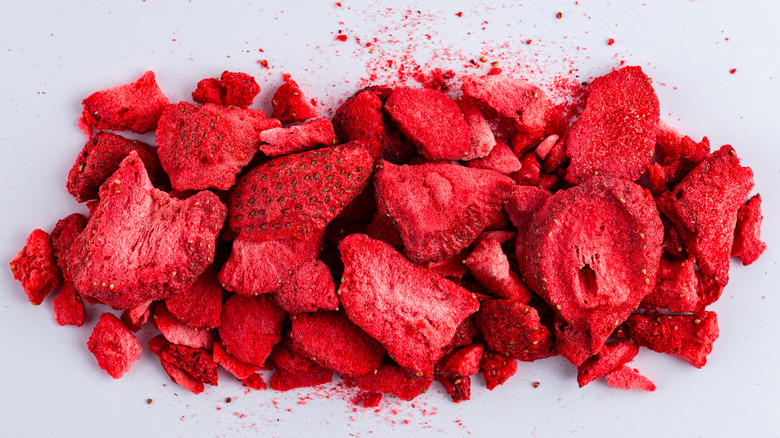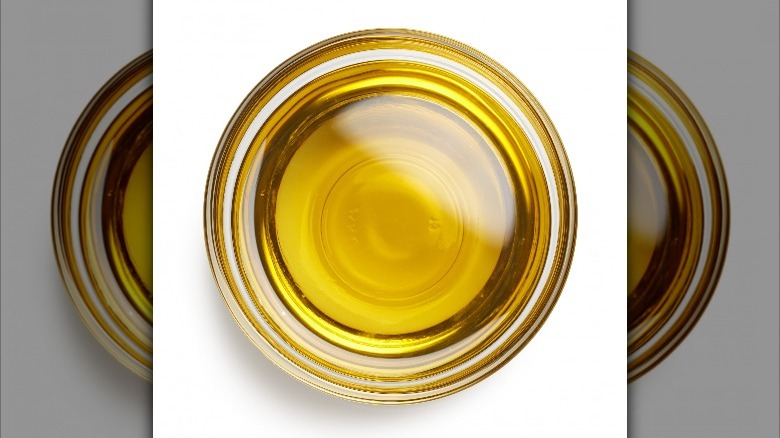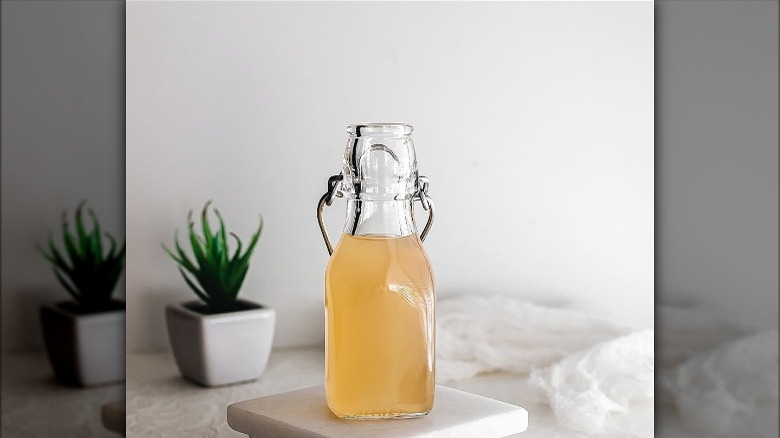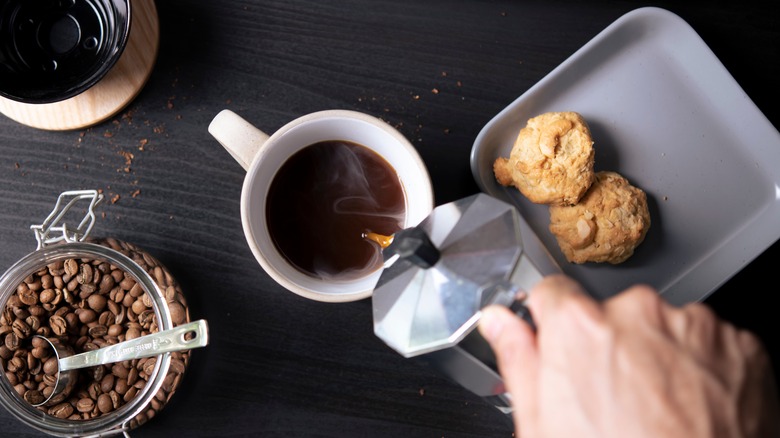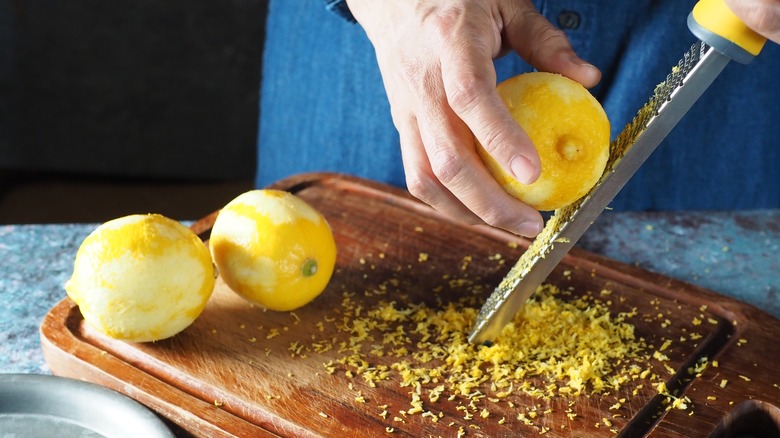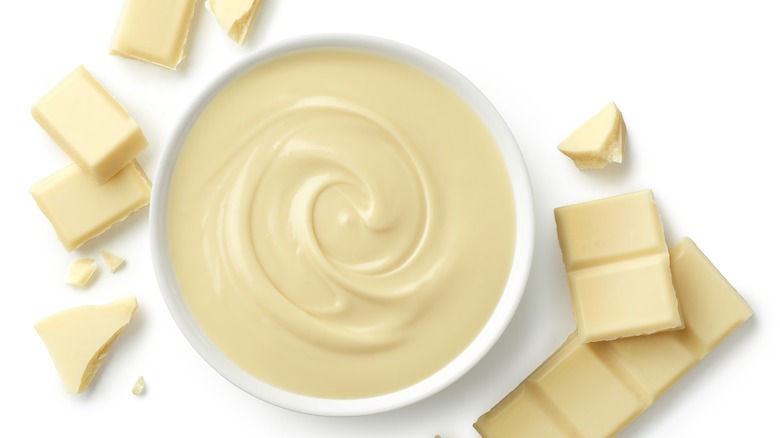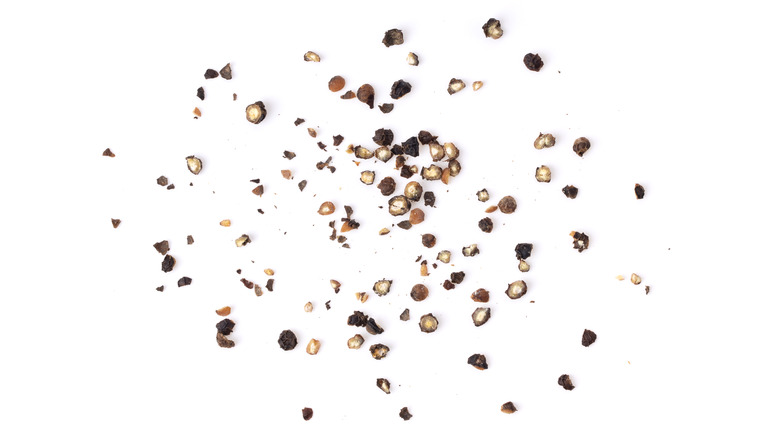Clever Ingredients That Will Elevate Your Baking Game
Baking is a craft that always seems to fill voids that we didn't even know existed: Hello, cronuts, and edible cookie dough. There's always a need for baked goods. It's impossible to tire of pastry, crusty bread, or gooey brownies. Why? Because whenever dough and batter are involved, buttery euphoria is always on the horizon.
For a while, crafty chocolate creations, mousse cakes, and dainty tartlets were left to the professionals: Those artisans that mill their own grains and source their own cream. Now, at-home bakers pull inspiration from shows like "The Great British Bake Off" and "Top Chef: Desserts" and experiment with ingredients, pushing themselves to achieve elevated perfection (although we all know that mastery is fleeting and the chase is half the fun).
If nothing else, slapping bread dough against the marble countertop is an effective way to relieve stress. There is no need to mill your own grains (although you are welcome to do so), but there are a few ingredients that will automatically turn your baking game up a notch.
European-style butter
Butter is an essential component of baking that lends a delicious hand to cookies, cakes, and pastries. Here in the U.S., we're used to buying butter in a one-pound box that is divided into four paper-wrapped sticks, each measuring eight tablespoons. Whether butter is chilled and cubed for pie dough or left at room temperature for aerated buttercream frosting, it is a cornerstone of the American baking pantry.
However, not all butter is the same. Enter European-style butter, better known stateside as "fancy butter," according to The Washington Post. So, what's the difference between foil-wrapped European blocks and American cubes? According to King Arthur Flour, grade A.A. butter (Ameden's preferred grade of butter with the best buttery flavor) contains a minimum of 80 percent butterfat, 18 percent water, and between 1 percent and 2 percent milk solids.
Instead, European butter has between 82 percent and 86 percent butterfat and less water, which can hugely impact the nature of certain baked goods. In addition, rich pale yellow butter precludes an extra-buttery taste, and the texture is softer and more pliable than grade A.A. butter.
How do you decide when European butter should be used to elevate your at-home baking projects? Lucinda Scala Quinn, food writer at The Washington Post suggests using European-style butter when you want a rich and nutty butter flavor to shine through, particularly for baked goods like shortbread, butter cookies, enriched bread, Breton cake, or pastry.
Vanilla bean paste
For decades, vanilla extract was the stylish flavor booster of choice, infusing cake batter and cookie dough with an aroma so sweet that bakers clamor to taste the mysterious dark liquid. A few years ago, an extract relative gained popularity in the baking world, adding a more intense vanilla bean flavor to baked goods without the hassle of seeding whole vanilla pods (via Nielsen Massey).
Vanilla bean paste is simply a loosely-textured paste with thousands of tiny vanilla seeds sold in a jar or tube. Those small specks disburse amongst lightly-colored dough as well as creams, and custards, adding an appearance just as luxurious as the taste. A good rule of thumb is to opt for vanilla bean paste in recipes that have sweet, woody, and creamy notes at the forefront.
Vanilla extract can be replaced with vanilla bean paste in vanilla-centric desserts. These sweet items could include sugar cookies, vanilla cake, ice cream, pudding, frosting, or creme brûlée (via The Pioneer Woman). But the options are truly limitless; meringue, cheesecake, rice pudding, French macarons, and donut glazes are just the beginning. If a recipe calls for a whole vanilla bean pod, simply swap it out with one tablespoon of vanilla bean paste for incredible flavor.
Almond flour
Almond flour is used in Paleo and gluten-free baking all the time. Still, its unique texture, sweet and nutty flavor, and buttery crumb make almond flour one of the baking world's best-kept secrets. According to The Washington Post, grocery stores carry both almond flour and almond meal; the former is made from skinned almonds and the latter from whole almonds, skins included. Either can be used for sweet or savory baking, although the brown-colored peel is noticeable in pale baked goods, so almond flour is often preferred.
Unlike all-purpose or bread flour, almond flour has no gluten at all. For this reason, baking with almond flour alone isn't recommended (unless a recipe specifies that bakers do so). On the other hand, almond flour can turn baked goods up a few notches in conjunction with regular flour. Frangipan, financier cakes, and shortcrust recipes benefit from a unique tenderness and an extra nutty flavor (especially if the almond flour is toasted). Try adding almond flour to pancakes, muffins, or cakes to elevate everyday baking projects into noteworthy repeats.
Brown butter
Brown butter has an innately enchanting quality. The nutty aroma is somewhere within the realm of sweet toasted nuts, piping hot donut oil, and warm toffee. Food bloggers and bakeries alike have embraced the liquid gold butter's nutty tendencies. By 2010, brown butter popularity skyrocketed, and the brown butter chocolate chip cookie trend took the blogosphere by storm (via Tastewise).
Brown butter doesn't take long to make, but it requires careful attention. According to King Arthur Flour, regular butter renders a nutty brown flavor after heat causes the water content to evaporate and the milk proteins and sugar to turn brown. Constant stirring is crucial to prevent the milk solids from burning or sticking to the bottom of the pan. Once you go through the melting, sizzling, and foaming process, you're left with a golden-colored liquid studded with little brown bits of toasted milk solids. The longer it cooks, the nuttier the butter becomes.
Adding brown butter to baked goods automatically elevates the final product with a sly nuttiness. Swap regular butter for browned butter in cookies, cake, shortbread, pie crust, buttercreams: Almost anything. Make sure the brown butter is at the proper temperature (room temperature, cooled, or chilled) to ensure the correct chemical baking process. Browning butter also changes the structural makeup of baked goods (like cookies) because it reduces the water content, so make sure to pay attention to the recipe's instructions.
Good quality chocolate
It should come as no surprise that the better the quality of an ingredient, the more delicious it is likely to taste. Quality usually entails a higher price, but the results are less processed, crafted with care, and often share a compelling origin story highlighting the thoughtful process. Chocolate is no different. A bar made from ethically sourced cacao beans, unbleached cacao butter, and without void of added preservatives will surely taste better than the processed, regular stuff.
In 2020, The New York Times reported an all-time high for handcrafted bean-to-bar chocolate offerings after a 19 percent sales spike in 2018. Since then, a strong faction of chocolate architects clamor for the best bean before personally roasting and grinding the cacao nibs.
Whether you're adding chocolate chunks to cookies or melting chocolate for a ganache tart, using good chocolate will automatically elevate the dish. Depending on the chocolate you choose, make sure you infuse fruity, herby, nutty, or even coffee or coconut notes into the dessert.
Some bars are heavy on cocoa butter, minimizing the bitterness of the beans and adding a creamy texture. But quality chocolate doesn't just elevate the flavor. Certain brands of chocolate chips hold their shape even after baking because of added stabilizers. A good-quality chocolate bar, chopped into large shards, medium pebbles, and shaved flakes, becomes one with cookie dough or brownie batter, melting into chocolate pools as the oven warms the pieces from the inside out (via Instagram).
Flaky salt
A new era of salt appreciation has led to the most compelling flavor combination in the culinary world: Sweet and salty. Chocolate chip cookies look naked without a salty crystal garnish, salted caramel ice cream only satisfies if the saltiness is a pervasive flavor, and chocolate pot de creme receives a light sprinkling to contrast the smooth and creamy chocolate custard.
What's an easy way to elevate your baking? Play the evolution card. According to Eater, humans are programmed to crave sugar, as it was an essential energy source thousands of years ago. To this day, the tongue has sugar receptors known as SGLT1. However, those sweet receptors activate even when salt is present: A scientific explanation to support repeated reminders to add salt to sweet recipes.
Mixing sweet and salty flavors is a joyful experiment. As former "Top Chef" contestant Malika Ameen explains, salt really works to enhance flavors. So, when should you turn to flaky or finishing salt to elevate your at-home baking? According to Martha Stewart, salts come in many sizes, shapes, and flavors.
Maldon salt is particularly large and crunchy, providing an unexpected texture to creamy desserts. Sel gris and fleur de sel are two other finishing salt options. Fleur de sel is the saltiest, and sel gris has a unique mineral flavor. Pair the crunchy salt with dark chocolate creations to bring out the sweetness and tame the bitterness. You can also pair Maldon salt with nutty and deeply caramelized innovations.
Nut butter
There will always be a time and place for peanut butter cookies and almond butter blondies. But if you're looking to one-up those staple nut spreads, head to a gourmet shop or online store to browse the vast world of colorful nutty drizzles.
Pistachio butter, hazelnut butter, pecan butter, and praline paste will quickly elevate standard buttercream, chocolate mousse, ganache, creamy sauces, or cake batters.
Consider pistachio gelato and the insanely green and aromatic nuttiness you taste and smell: That's all pistachio butter.
The American Pistachio Growers recommend adding grassy green pistachio butter to ice cream, mousses, frangipane, pastry fillings, buttercream, and pastry cream. Hazelnut or pecan butter can be used the same way. Any nut butter can be mixed with chocolate to create a smooth, nutty, and sweet chocolate confection known as gianduja. Just make sure the butter you buy is made with 100% of the advertised nut.
According to Britannica, praline is a French confection consisting of nuts coated in sugar, vanilla, and sometimes spices. Praline paste is a nut butter cousin made from praline. The seasoned hot sugar coats the nuts, and after it cools, they are blended into a paste to be added to other desserts. Any nut variety can be turned into praline, including almonds, pecans, walnuts, pistachios, and pine nuts. Each type of nut will add a unique nuttiness and will lead to excellent and versatile nut butter.
Freeze-dried berries
Fresh isn't always better, especially when it comes to baking. Sure, a fresh blueberry pie or bubbling peach crisp relies on fresh fruit alone, but freeze-dried fruit is a secret ingredient that adds concentrated flavor to fruity desserts (via The Washington Post). Before adding to baked goods, the fruit must be pulverized in a blender, food processor, coffee grinder, or a mortar and pestle until it is as thin as fine paper (via Bon Appétit).
So, why bother using freeze-dried fruit at all when you have access to fresh? The answer is simple. The flavor is more concentrated, and freeze-dried fruitiness isn't dependent on the seasons. It also ensures a bold fruity and tart flavor without adding extra moisture, which can throw a recipe off entirely.
As pie and baking queen Erin McDowell explains, it's akin to mixing cocoa powder into cookie dough. You can add freeze-dried fruit powder to buttercreams, flavored sugars, meringue, and even Rice Krispie bar goo without altering the necessary dry-to-wet ratios.
Freeze-dried raspberries, strawberries, mango, blueberry, and peach are excellent options. After the fruit is transformed into a powder, it can be mixed into batter, icing, and dough. The powdered fruit can also be mixed with granulated or powdered sugar for donuts, lemon bars, and marshmallow dustings (via King Arthur Flour). Just make sure you keep your freeze-dried fruit properly sealed. Any exposure to moisture will soften the fruit, thus preventing it from properly blending into a powder.
Extra virgin olive oil
Extra-virgin olive oil is often applauded for its health benefits: It's packed with numerous healthy fats and antioxidants, and it's often consumed as part of a notoriously healthy Mediterranean diet. But health aside, olive oil tastes great and has a lot to offer, not just in the savory cooking world but in the sweet baking world as well.
According to Saveur, extra-virgin olive oil adds unique fruitiness and individuality to a dish, depending on where the olives were harvested and how they were processed. Mild extra-virgin olive oils are perfect for sweet baking, adding a buttery quality that pairs perfectly with nuts and fruit. Meanwhile, dark chocolate and heavily spiced recipes mix well with peppery and grassy olive oils.
Olive oil also keeps baked goods moist for longer, an added benefit for large-batch or make-ahead baking (like cakes) because the oil remains liquid at room temperature (via Brightland). Remember, you can only swap butter for extra-virgin olive oil in specific recipes.
Olive oil cakes, scented with citrus zest and fortified with almond flour, are an excellent place to start. Or, simply swap the melted butter for olive oil in your favorite baklava recipes. Because olive oil doesn't have any water content, the phyllo dough is extra crisp, and the fruity flavor compliments the buttery nut mixture.
Simple syrup
Simple syrup isn't just used for cocktails and baklava. Adding simple syrup is a genius cake-baking strategy. Flavored simple syrup is the ingredient behind elevated cakes, as well as strokes of pastry brush-soaked bristles that coat exposed or pierced sponge with extra moisture and flavor.
Cake simple syrups are called cake soaks, according to MasterClass, and are designed to add flavor and moisture or rescue an otherwise dry sponge. The soak is made from equal parts sugar and water, but other liquids like juice, liqueur, zest, herbs, tea, spices, or steeped whole fruit can add extra flavor.
After the syrup is cooled, use a pastry brush to pat it into the sponge, making sure not to oversoak it (or the cake will crumble). According to Caroline Wright, author of "Cake Magic," you can soak cake layers in syrup once they've finished backing and have emerged from the oven
Simple syrups can also be used as a glaze for baked goods like babka. A traditional extra thick syrup (less water than sugar) coats the braided bread and crystallizes as it cools, adding additional texture and sweetness. The twice-baked almond croissants at Bakery Nouveau in Seattle, Washington, are dipped in simple syrup after their first bake and then thrown back in the oven to harden into soft buttery pastry.
Coffee
The Italians were ahead of the game. Tiramisu and affogato are arguably two of the best dessert coffee creations, paving a path for the rest of the world to take full advantage of coffee's baking flavor boost. Specifically, coffee pairs well with two dessert camps: Cream desserts and chocolate desserts.
Coffee's natural bitterness magically pairs with light and sweet creams: Anything from mascarpone tiramisu creams to coffee creme patisserie and coffee ice cream. The rich cream cuts through the bitterness of the coffee. In the case of tiramisu, even coffee haters are lured in by soaked lady fingers magically tamed with a lightly sweetened mascarpone cream.
Coffee additions can come in many forms, not just liquid. Beloved food television host and cookbook author Ina Garten is notorious for adding espresso powder into chocolate baked goods like brownies and cakes. Why? Coffee makes chocolate take even more chocolatey.
According to coffee consultant Natasha Shariff, coffee and chocolate pair very well together (via Michelin). Coffee enhances chocolate's flavor with just a few tablespoons. The result? Happily mystified faces loaded with brownie crumb deliciousness.
Lemon zest
Every cook should own a Microplane, not just to grate parmesan cheese but to harvest the lemon's best-kept secret: The zest. Great lemons desserts should rely on the zest just as much as on the juice, if not more. According to Spiceography, the zest of the lemon refers to the brightly colored yellow outer skin. The white skin underneath is bitter, so the Microplane works well to collect just the colorful bits, rotating the lemon until all the zest is ready for baking.
Some recipes like lemon curd or lemon bars use lemon juice for a tart flavor and consistency that turns creamy when eggs are involved. But the zest can be added to pretty much anything, as long as the flavors meld. Generally, lemon zest is best paired with neutral cake and muffin batters (like vanilla), berry desserts and sauces, and butter cookies (like sugar cookies, Mexican wedding cookies, or shortbread).
Lemon zest is full of essential oils, so unlike lemon juice, the zest infuses baked goods with floral citrus notes without giving them a sharp tang. Lemon zest brings out the flavor of juicy berries concoctions (much like coffee enhances chocolate), adding a complexity that isn't easily recognized but is very much noticed.
White chocolate
White chocolate is a foundational baking ingredient, yet white chocolate critics cloud the airspace, leaving this cacao product incredibly under-appreciated. Eating raw white chocolate doesn't have to be the end all be all of white chocolate. According to Food Network, white chocolate is the perfect sidekick to any strong flavor. Its sweetness, butteriness, and neutral flavor have the power to tame sharp citrus, complement dark chocolate, and help stabilize filings, custards, and creams.
Unlike standard chocolate, white chocolate can be paired with a range of different fruits. Dried cranberries and white chocolate chunks can be folded into cookie dough, and white chocolate mousse is automatically elevated with the addition of fresh raspberries. Priority number one for any white chocolate baking endeavor is to always use good quality white chocolate. Look for a bar that is yellowish in color, not bleached white. Cocoa butter and milk solids should be the only source of fat in white chocolate in addition to sugar, lecithin, and vanilla (via Food52).
Black pepper
Generally speaking, black pepper isn't considered a baking pantry staple. But don't knock the seemingly savory-only ingredient just yet. Black pepper has been incorporated into sweet recipes since Roman times (via The Atlantic). German and Dutch Pfeffernüsse cookies often feature a mixture of nutmeg, cloves, anise, cinnamon, and black pepper.
Black pepper isn't a shy ingredient. It provides a lovely warmth treasured plates of cacio e pepe pasta, and it will do the same to baked goods, minus the cheese. Intensely sweet ingredients like syrups and honey are an excellent place to start incorporating black pepper into your dessert repertoire.
Try simmering a few cracks of fresh black pepper or whole peppercorns with a cinnamon stick and vanilla pod in syrup before poaching apples, peaches, or pears. A sweet stickiness mellows the strong pepper flavor, adding slight warmth to an otherwise milky sweetness.
Unsurprisingly, black pepper and other warming spices are a flawless combination. Belgian speculoos cookies contain white pepper in conjunction with cinnamon, cloves, nutmeg, ginger, and cardamom (via TasteAtlas). For any dessert, cookie, or otherwise, use freshly cracked pepper for maximum flavor.
